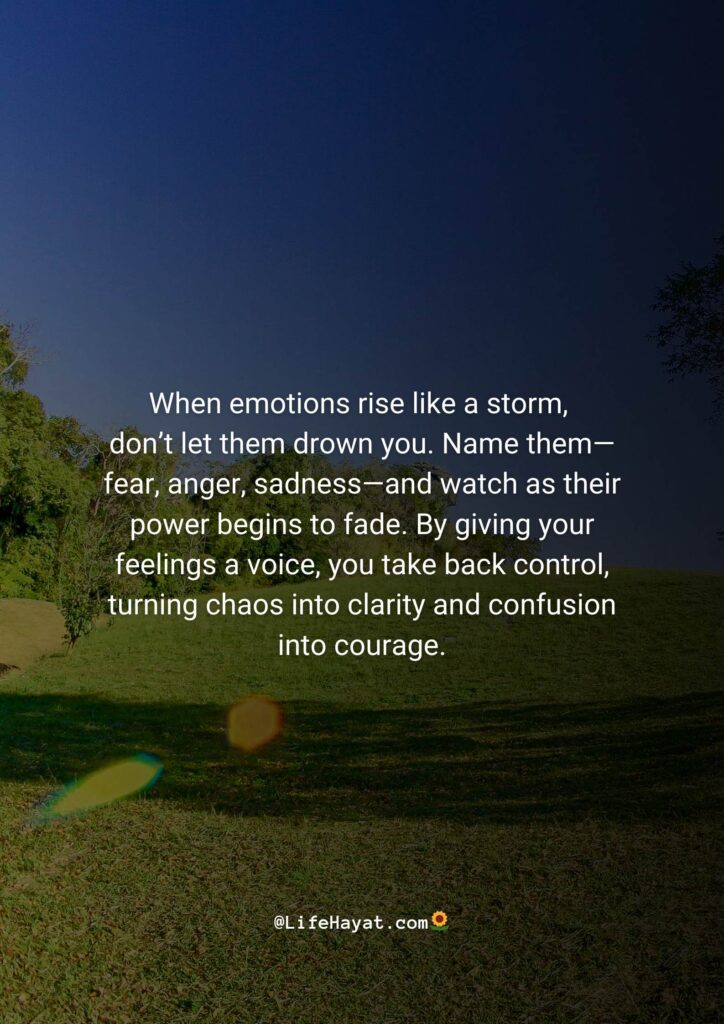
How to Manage Overwhelming Feelings: A Compassionate Guide to Emotional Resilience
Life can feel like a storm sometimes, with emotions crashing over us like waves. It’s about how to manage overwhelming feelings whether it’s stress, anxiety, sadness, or frustration that can leave us feeling lost and powerless. But here’s the truth: you are stronger than you think, and you have the power to navigate these emotional tides.
Learning how to manage overwhelming feelings is not about suppressing or ignoring them—it’s about understanding, processing, and transforming them into tools for growth. This article will guide you through scientifically-backed, realistic strategies to help you regain control and find peace.
Why Overwhelming Feelings Happen: You’re Not Alone
Before diving into how to manage overwhelming feelings, it’s important to understand why they happen. Emotions are a natural part of being human. They’re signals from your brain and body, telling you something needs attention.
When life feels chaotic, your brain’s amygdala (the emotional center) can go into overdrive, triggering a fight-or-flight response. This can make even small problems feel insurmountable. But remember, feeling overwhelmed doesn’t mean you’re weak—it means you’re human. And just like any skill, emotional management can be learned and strengthened.
Table of Contents
- How to Manage Overwhelming Feelings: A Compassionate Guide to Emotional Resilience
- Why Overwhelming Feelings Happen: You’re Not Alone
- 1. Pause and Breathe: The Power of Grounding Techniques
- 2. Name It to Tame It: The Science of Labeling Emotions
- 3. Break It Down: The Art of Chunking
- 4. Practice Self-Compassion: Be Kind to Yourself
- 5. Seek Connection: You Don’t Have to Do It Alone
- 6. Move Your Body: The Mind-Body Connection
- 7. Create a Calm Space: Your Emotional Sanctuary
- 8. Reflect and Grow: Turn Challenges into Lessons
- Conclusion: You Have the Power to Manage Overwhelming Feelings
1. Pause and Breathe: The Power of Grounding Techniques
“When life feels chaotic, remember to pause and breathe. Inhale courage, exhale doubt. A single moment of stillness can reset your mind, refocus your energy, and remind you that you have the strength to keep going.”

When emotions feel like they’re spiraling out of control, the first step is to pause. Grounding techniques are simple yet powerful tools to bring you back to the present moment. One of the most effective methods is deep breathing. Research shows that slow, intentional breaths activate the parasympathetic nervous system, which calms your body and mind.
Try this:
- Sit or stand comfortably.
- Inhale deeply through your nose for 4 seconds.
- Hold your breath for 4 seconds.
- Exhale slowly through your mouth for 6 seconds.
- Repeat 5-10 times.
This technique can help you regain clarity and create space between you and your emotions. Remember, you don’t have to solve everything at once—just focus on this moment.
2. Name It to Tame It: The Science of Labeling Emotions
“When emotions rise like a storm, don’t let them drown you. Name them—fear, anger, sadness—and watch as their power begins to fade. By giving your feelings a voice, you take back control, turning chaos into clarity and confusion into courage.”

One of the most effective ways to manage overwhelming feelings is to identify and name them. Psychologists call this “affect labeling,” and studies have shown that simply putting your emotions into words can reduce their intensity. For example, instead of saying, “I feel bad,” try to be specific: “I feel anxious because of my workload” or “I feel hurt by that comment.”
Writing down your emotions in a journal can also help. This practice not only clarifies what you’re feeling but also helps you spot patterns over time. By understanding your triggers, you can develop healthier responses and build emotional resilience.
3. Break It Down: The Art of Chunking
“The journey to success may seem impossible when you look at the peak, but remember: every mountain is climbed one step at a time. Focus on the next move, not the entire path. With patience, persistence, and belief in yourself, you’ll reach heights you once thought were out of reach.”

When life feels overwhelming, it’s often because we’re trying to tackle everything at once. The solution? Break it down. This strategy, known as “chunking,” involves dividing big tasks or problems into smaller, manageable pieces. For example, if you’re feeling overwhelmed by a project, list out the steps needed to complete it and focus on one at a time.
Here’s how to apply this to emotions:
- Identify the source of your overwhelm.
- Break it into smaller, actionable steps.
- Focus on completing one step before moving to the next.
By taking things one piece at a time, you’ll feel more in control and less burdened by the weight of everything at once.
4. Practice Self-Compassion: Be Kind to Yourself
“You are the one person who will always be with you—through every high and low. Treat yourself with the same compassion, patience, and kindness you’d offer a dear friend. After all, the relationship you have with yourself sets the tone for every other relationship in your life.”

When emotions feel overwhelming, it’s easy to fall into self-criticism. But beating yourself up only adds to the emotional load. Instead, practice self-compassion. According to Dr. Kristin Neff, a leading researcher on self-compassion, treating yourself with kindness during tough times can reduce stress and improve emotional well-being.
Here’s how to start:
- Acknowledge your feelings without judgment.
- Remind yourself that everyone struggles sometimes.
- Speak to yourself as you would to a close friend.
Self-compassion isn’t about letting yourself off the hook—it’s about recognizing your humanity and giving yourself the support you need to move forward.
5. Seek Connection: You Don’t Have to Do It Alone
“A burden shared is a burden halved—reach out and let others lighten the load.”

Humans are wired for connection. When emotions feel overwhelming, talking to someone you trust can make a world of difference. Whether it’s a friend, family member, or therapist, sharing your feelings can provide relief and perspective. Studies show that social support can reduce stress and improve mental health.
If you’re hesitant to open up, start small. Share one thing that’s on your mind, and see how it feels. Remember, vulnerability is a strength, not a weakness. By reaching out, you’re taking a powerful step toward healing.
“No one is meant to carry their struggles alone. When you share your burden, you don’t just lighten the weight—you open the door to connection, support, and healing. Reach out, let others in, and remember: strength isn’t about bearing it all yourself; it’s about knowing when to ask for help.”
6. Move Your Body: The Mind-Body Connection
“Motion creates emotion—move your body to shift your mindset. Let your energy flow toward positivity and clarity.”

Physical activity is one of the most effective ways to manage overwhelming feelings. Exercise releases endorphins, the brain’s natural mood boosters, and helps reduce stress hormones like cortisol. You don’t need to run a marathon—even a short walk, yoga session, or dance break can make a difference.
Try this:
- Set a timer for 10 minutes.
- Do something active—stretch, walk, or dance.
- Notice how your body and mind feel afterward.
Movement not only helps regulate emotions but also gives you a sense of accomplishment, which can counteract feelings of overwhelm.
7. Create a Calm Space: Your Emotional Sanctuary
“Your environment shapes your emotions—create a space that nurtures your soul.”
Your surroundings can have a big impact on your emotional state. If you’re feeling overwhelmed, take a few minutes to create a calm, comforting space. This could mean decluttering your desk or lighting a candle. Research shows that a tidy, peaceful environment can reduce stress and improve focus.
Here’s how to start:
- Identify one area you can tidy or organize.
- Add elements that bring you joy, like plants or photos.
- Use this space as a retreat when emotions feel too much.
By creating a physical sanctuary, you’re also building an emotional one.
8. Reflect and Grow: Turn Challenges into Lessons
“Storms may shake you, but they also teach you how to navigate the seas of life. Each challenge is a lesson, each struggle a chance to grow stronger. Embrace the winds of change, and let them guide you toward resilience and wisdom.”

Finally, take time to reflect on your experiences. When you’ve navigated a wave of overwhelming emotions, ask yourself:
- What did I learn from this?
- What strategies helped me cope?
- How can I use this experience to grow?
Reflection turns challenges into opportunities for growth. By understanding your emotional patterns, you can develop a toolkit for managing future storms with confidence and grace.
Each Day A New Beginning – 21 Positive Quotes
Conclusion: You Have the Power to Manage Overwhelming Feelings
Learning how to manage overwhelming feelings is a journey, not a destination. It takes practice, patience, and self-compassion. But with each step, you’ll grow stronger and more resilient. Remember, you are not your emotions—you are the one who holds the power to navigate them. By using these strategies, you can transform overwhelming feelings into stepping stones toward a calmer, more empowered you.
You’ve got this. One breath, one step, one moment at a time.


Indeed Dear Chaymaa as i Understand All too Well From Not Understanding
The Limits of Being Human Exposed to Chronic to Acute Fight or Flight Stress
Work Related for 11 Years
Ending Up Almost Killing
me with What is Described
As Both “General Adaptation
Syndrome” for Total Human or
Other Animal Exhaustion in Adapting
To the Environment
They Are in or “Autism
Burn-Out” Particularly
Difficult for Someone
Who Takes too Much In
Without the Ability to
Escape All the Feelings
And Senses Associated
With Existing in Everyday Life in
Constant Bombardment of Modernity
Hehe Others Just Ignore it All and Go on…
You Provide Some Good Suggestions to Battle
Chronic Stress
In the Parasympathetic
Response Defeating the
Sympathetic one Through
Breathing Deeply in Inhaling
And Exhaling Escaping to the
Present Moment Out of Stress
Labeling Emotions Words in Touch
With Feelings Senses One Move One Word
Now Instead of Worrying About the Rest Now
A First Step to Compassion Is Feeling We Matter
And True in Warm Connection There is Healing of
Pain and Anxiety as Oxytocin the Social Bonding
Neurohormone Naturally Brings Ah Yes Moving Now
and Connecting Not Only With Others yet Connecting
Mind to Body too as Emotions Flow From Toes to Head
in a Synergy of All Our Feelings and Senses Now Yes A Dance
And Song Toward Positivity Clarity And Co-Creativity With Others too
So Difficult When
We Can’t Seem
to Find Any
Place of
Sanctity
Where the Only
Place Left May
Be the Great Within
We come to Be With a Resounding
i
AM
Evolving
As Fully
Human Now
Resilient More for
What Now Brings Next
So Many New And Creative Ways
to
Escape
Survive
And Even Thrive
Regulating Emotions
Integrating Senses
With SMiLes Giving
Sharing Caring Healing
All Others too With Most
Respect and Least Harm
iN JoY oF LiGHT
iNHaLinG Peace
EXHaLinG LoVE
Lifting
Up More
With
SMiLes
Now
Than
Tearing
Our
Selves
And Others Down
A Way of RiSinG
More than falling..:)